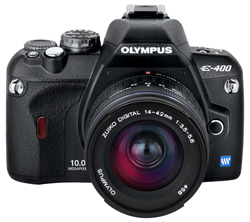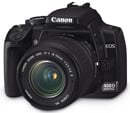Olympus E-400 with Zuiko Digital 14-42mm f3.5-5.6 ED
-
-
Written by Gordon Laing
Olympus E-400 verdict
As the world’s smallest and lightest digital SLR to date, the Olympus E-400 is certainly a very compact product – as we mentioned on the Design page, it even manages to make the Canon 400D / XTi look quite hefty. But while miniaturisation is always technically impressive, reduced dimensions signal alarm bells in terms of comfort and usability. Thankfully there’s no cause for concern with the E-400 though. It’s perfectly comfortable to hold and use, and indeed the lack of a conventional grip prevents your fingertips from becoming pinched between it and the barrel. Our only criticism is the right strap eyelet can dig into your hand a little.
The two new kit lenses may also be considerably smaller and lighter than the previous Four Thirds twin lens kit, but again there don’t appear to be any compromises as a consequence. As our optical results show, the new Zuiko Digital 14-42mm actually out-performs the older 14-45mm in many respects and also offers a closer focusing distance. We did spot out-of-focus bokeh artefacts which may displease some photographers (see Gallery), but for general purpose use, it’s a great quality kit lens – and it’s also nice to find internal focusing and a lens hood thrown in at this price point.
 | |
Despite being pitched as an entry-level camera, the new Kodak 10 Megapixel sensor makes the E-400 the highest resolution Four Thirds body to date. The resolvable detail is certainly up there with rival 10 Megapixel DSLRs, although as our results show, the noise levels are more obvious especially at higher sensitivities. It is however important to look beyond the speckles, as the E-400 retains a high degree of detail which other cameras often smear-out when attempting to reduce the noise. We prefer the E-400’s approach because at least the detail’s there if you want it, and you can always apply noise reduction with third party software later if preferred.
The SSWF anti-dust filter was always a highlight of Olympus DSLRs, and the E-400’s no different. We left the E-400 body open without a lens for several minutes both indoors and out, and still found virtually no evidence of dust on the images – see our anti dust page for full details. And while the E-400 performs its cleaning process upon every power-up whether you like it or not, it’s much quicker to start than previous Olympus DSLRs. So far, so good for the E-400, but how does it compare to its closest rivals?
Compared to Canon EOS 400D / Rebel XTi
 | |
The Canon EOS 400D / XTi is already the best-selling 10 Megapixel DSLR and arguably the E-400’s biggest rival. Interestingly though, two of the aspects the 400D / XTi sells itself on – compact size and anti-dust – are both bettered by the Olympus. The 400D / XTi may also offer a wide variety of anti-dust options, but in our tests they were less effective the E-400. The Olympus body is also noticeably smaller than the 400D without compromising comfort. The E-400’s kit lens is additionally superior in many optical respects, and unlike the Canon kit, features internal focusing and a lens hood.
So far it sounds like the E-400’s winning hands down, but the Canon 400D / XTi delivers lower apparent noise, especially at higher sensitivities and fractionally out-resolves it in technical charts; the view through the viewfinder is also wider. So if you demand silky-smooth JPEGs out of the camera at high sensitivities and prefer a bigger grip to wrap your fingers around, go for the Canon. Crucially, the 400D / XTi is also working out cheaper from internet dealers. See our Canon EOS 400D / XTi review for more details.
Compared to Sony Alpha A100
The Sony Alpha A100 is the other big-selling ‘affordable’ 10 Megapixel DSLR around right now, and again the E-400 beats it in terms of size and effective anti-dust facilities. In terms of quality though, the Sony, like the Canon 400D / XTi slightly out-resolves the E-400 in technical charts, although interestingly its noise levels are roughly the same.
The Sony A100’s big selling point though is built-in anti-shake, and this is the big downside with the E-400. While we didn’t expect the E-400’s kit lens to include anti-shake, none of the Olympus Zuiko Digital lenses offer the facility. In fact the only anti-shake lens right now for any Four Thirds body is the Leica 14-50mm, which isn’t a practical option for most people. So the A100 wins on anti-shake and of course a bigger grip if you prefer that sort of thing, but the E-400 takes the lead on portability and anti-dust. See our Sony Alpha A100 review for more details.
Compared to Olympus E-500
 | |
The E-500 isn’t replaced by the new E-400, so if you’ve decided a Four Thirds body is the way to go, both models could be on your shortlist. Despite being pitched as an entry-level model though, the new E-400 is superior in almost every respect. It’s higher resolution, starts-up quicker and features smaller and better quality kit lenses. And even though the E-400’s noise levels are quite visible, they’re no worse than the E-500. So the only reason you’d go for the E-500 over the E-400 was if you really didn’t get on with the smaller body of the new model. See our Olympus E-500 review for more details.
Final verdict
The Olympus E-400 has a lot going for it. It’s very small and light without compromising comfort or usability, there’s quick and easy access to all the settings, the resolving power roughly matches rival 10 Megapixel DSLRs, and while noise speckles are more noticeable at higher sensitivities, at least there’s no smearing through noise reduction. And finally the kit lens is decent quality and the SSWF anti-dust system remains unmatched.
On the downside are some Four Thirds foibles which to be fair affect all models and may or may not bother you. First, the viewfinder, while a big improvement over the E-330 and Panasonic L1, is still narrower than that on other DSLRs. Secondly the manual focusing is motor-assisted which means the camera needs to be powered-up for it to work, and it’s missing the ultimate tactile feeling of a mechanical system.
The biggest problem facing the E-400 though are its two toughest rivals. The Canon 400D / XTi may fall behind in many respects, but delivers smoother JPEGs out the camera at high sensitivities and thanks to heavy discounting, is typically available cheaper. Then there’s the Sony Alpha A100 which taunts the E-400 and indeed most Four Thirds cameras with its anti-shake. Since Olympus believes in-lens optical stabilisation isn’t the way forward, the only anti-shake solution for the E-400 today is the prohibitively pricey Leica 14-50mm lens. We can only hope Sigma produces an affordable alternative.
Then there’s the fact the E-400 is only officially sold in Europe. That said, there’s plenty of dealers in the UK who’ll ship internationally, if you’re willing to accept a UK warranty. If you’re visiting the UK you could also buy an E-400 from a store which supports the VAT Retail Export Scheme, check the camera out in person, then claim back most of the tax when you leave the country. So while it’s not an ideal situation for people outside Europe, it’s far from insurmountable.
 |
Ultimately while the E-400’s key rivals can work out cheaper from some dealers, it still easily earns itself a Highly Recommended rating. The quality and controls are very good, the compact body is extremely portable without compromising handling, and the SSWF remains the only anti-dust system we’ve tested which seems genuinely effective. The E-400 will equally appeal to first-time DSLR buyers and experienced photographers who want a compact body with decent creative control. For the E-400’s highlights, see our video tour, and visit our Budget DSLR Buyer’s Guide for an update of the best buys around right now.
NEW: For a full report of the E-400’s successor, with worldwide availability, check out our Olympus E-410 review.
|
Good points Bad points |  Scores | |||
Build quality: Image quality: Handling: Specification: Value:
Overall: |
14 / 20 18 / 20 15 / 20 19 / 20 19 / 20
85% | |||




